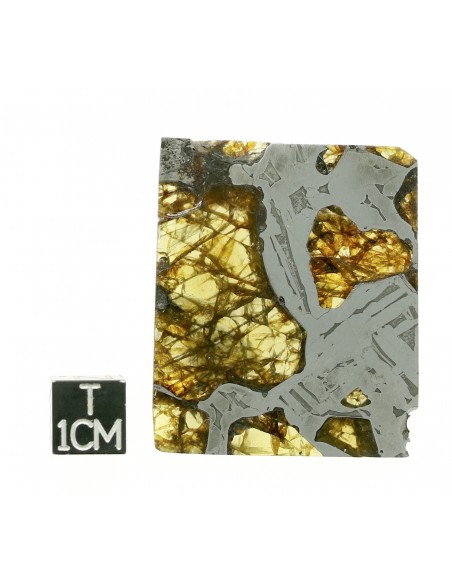FUKANG Pallasite 11,90 g qualité AAA +
Tranche de la pallasite de Fukang (qualité AAA +) avec de gros cristaux d'olivine et des structures de Widmanstätten révélées, d'un poids de 11,90 g pour des dimensions de 42 x 36 x 2 mm.
Un certificat d'authenticité signé, intégrant la photo de la pallasite, accompagne la météorite.
Tranche de la pallasite de Fukang de qualité AAA+. Cette tranche révèle aussi de superbes cristaux d'olivine, la lumière passant à travers, dont certains sont de qualité gemme ce qui est extrêmement rare pour les pallasites.
Les pallasites sont considérées à juste titre comme les reines des météorites, les plus esthétiques, spécialement lorsqu'elles sont coupées en tranches fines et polies. Ce groupe de météorites consiste en un alliage de fer-nickel qui semble "baigner" des cristaux d'olivine de couleur jaune miel à vert olive.
Références du Meteoritcal Bulletin Database
| Fukang | |||||||
|---|---|---|---|---|---|---|---|
| Basic information | Name: Fukang This is an OFFICIAL meteorite name. Abbreviation: There is no official abbreviation for this meteorite. Observed fall: No Year found: 2000 Country: China Mass: 1 t |
||||||
| Classification history: |
This is 1 of 43 approved meteorites (plus 1 unapproved name) classified as Pallasite, PMG. [show all] Search for other: Main group pallasites, Metal-rich meteorites, and Pallasites |
||||||
| Comments: | Approved 3 Feb 2006 Revised 26 May 2009: Revised pallasite classifications |
||||||
| Writeup | Writeup from MB 90: Fukang 44°26′N, 87°38′E Fukang, Xinjiang Province Find: 2000 Pallasite (main group) History: An anonymous finder recovered a 1003 kg specimen near Fukang, China, in 2000. The sample was at the Tucson Gem and Mineral Show in February 2005, and seen by D. S. Lauretta of UAz. Approximately 20 kg had been removed from the main mass by the finder before the Tuscon show and the mass investigated at UAz was 983 kg. (D. S. Lauretta, D. Hill, M. Killgore, D. Della-Giustina, Y. Goreva, UAz; I. Franchi, OpenU). Petrography and Geochemistry: Olivine: Throughout the large mass, olivines vary in shape from rounded to angular; many are fractured. They range in size from <5 mm to several cm. The main pallasite contains several regions of “massive” olivine clusters up to 11 cm in diameter with thin metal veins only a few millimeters in width. Fo86.4 with molar Fe/Mg = 0.1367, Fe/Mn = 40.37, and Ni = 0.03 wt%. Zoning was not observed for Al, Cr, Ca, Mn, or Fe typical of olivines in main-group pallasites. Metal and sulfides: Groundmass is mostly kamacite with some occurrences of kamacite mantles surrounding taenite cores, rounded taenite adjacent to kamacite, and regions of “comb plessite. ” Kamacite contains an average Ni = 6.98 wt%. Schreibersite is enclosed by wide kamacite bands and as mantles adjacent to olivines. Two populations of schreibersite are present with Ni = 26 and 35 wt% near chromite. Vermicular sulfide (troilite) is present in some olivine. Thin veins of kamacite and troilite occur inside many olivines as well. Minor phases: Euhedral chromites up to 0.5 cm, rounded whitlockite adjacent to olivine, and troilite heterogeneously distributed in thin veins. Several regions, ranging from <100 µm to several millimeters, that contain a complex mixture of olivine, low-Ca pyroxene, troilite, and whitlockite were observed adjacent to chromite. Bulk composition: Fe = 89.9 ± 0.3, Ni = 9.0 ± 0.2, P = 0.62 ± 0.02, Co = 0.51 ± 0.01 (all wt%); Ge = 41 ± 4, As = 26 ± 5, Ga = 19.1 ± 0.5, Pd = 5.1 ± 0.2, Au = 2.6 ± 0.2, (all µg/g); Ir = 43 ± 4 ng/g. Oxygen isotopes: δ18O = 2.569, δ17O = 1.179, ∆1 7O = −0.157 (all ‰). Classification: Pallasite (main group). Specimens: A total of 31 kg of type specimen is on deposit at UAz. M. Killgore holds a total of 31 kg. An anonymous collector holds the main mass. |
- Dr Luc Labenne
Membre de la Meteoritical Society






